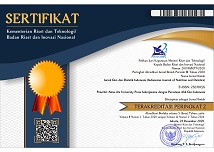Determinants of type 2 diabetes mellitus in agricultural community
Abstract
ABSTRAK
Latar Belakang: Prevalensi DM di perkotaan sebanyak 2,6% dibandingkan pedesaan sebanyak 1,4%. Namun hal yang cukup menarik, proporsi Glukosa Darah Puasa Terganggu (GDPT) dan Toleransi Glukosa Terganggu (TGT) pada penduduk di pedesaan lebih tinggi dibandingkan perkotaan yaitu 3,7% dan 5,4%. Hal ini menunjukkan bahwa penduduk di pedesaan lebih berisiko terkena DM tipe 2 jika tidak dilakukan intervensi.
Tujuan: Penelitian ini bertujuan menganalisis determinan kejadian DM tipe 2 pada populasi agrikultur
Metode: Jenis penelitian adalah case control study, dengan sampel penelitian adalah petani yang menderita DM tipe 2 (kasus) dan petani yang tidak menerita DM (kontrol). Penelitian dilaksanakan di Kecamatan Gedong Tataan Kabupaten Pesawaran dengan jumlah masing-masing kelompok sebanyak 41 orang. Pengambilan data dilakukan dengan mengukur Indeks Massa Tubuh, tekanan darah, wawancara dengan kuesioner IPAQ-SF dan Indeks Brinkmann
Hasil: Hasil penelitian didapatkan jumlah jenis pestisida, faktor genetik dan aktifitas fisik merupakan faktor determinan terjadinya DM tipe 2. Responden yang menggunakan pestisida ≥ 2jenis pestisida memiliki risiko 2,7 kali kemungkinan menderita DM tipe 2 dibanding yang menggunakan 1 jenis pestisida. Responden dengan riwayat keluarga menderita DM memililiki kemungkinan (odds) 16,03 kali menderita DM dibandingkan yang tidak memiliki riwayat keluarga DM. Respoden dengan aktifitas fisik rendah memiliki kemungkinan (odds) 4,154 menderita DM dibandingkan responden dengan yang memiliki aktifitas fisik tinggi.
Kesimpulan: Diperlukan upaya promotif dan preventif terutama untuk masyarakat yang menggunakan pestisida ≥ 2jenis pestisida, riwayat keluarga menderita DM tipe 2 dan aktifitas fisik rendah.
KATA KUNCI: DM tipe 2: faktor risiko, , populasi agrikultur
ABSTRACT
Background: The prevalence of type 2 Diabetes Mellitus (DM) in urban areas was 2.6% compared to 1.4% in rural areas. However, what is quite interesting is that the proportion of disturbed fasting blood glucose (GDPT) and impaired glucose tolerance (TGT) in rural residents is higher than in urban areas, namely 3.7% and 5.4%, respectively. This shows that rural residents are more at risk of developing type 2 DM if no intervention is carried out.
Objectives: This study aims to analyze the determinants of the prevalence of type 2 DM in the agricultural population.
Methods: This type of research is a case-control study, with the sample being farmers who suffer from type 2 DM (cases) and farmers who do not suffer from DM (controls). The research was conducted in Gedong Tataan District, Pesawaran Regency with the number of each group as many as 41 people. Data were collected by measuring Body Mass Index, and blood pressure, interviews with the IPAQ-SF questionnaire, and the Brinkmann Index.
Results: The results showed that the number of types of pesticides, genetic factors, and physical activity were the determining factors for the occurrence of type 2 DM. Respondents who used pesticides 2 types of pesticides had a 2.7 times risk of suffering from type 2 DM compared to those who used 1 type of pesticide. Respondents with a family history of DM have a 16.03 times possibility of suffering from DM compared to those without a family history of DM. Respondents with low physical activity had 4,154 chances of suffering from DM compared to respondents who had high physical activity.
Conclusions: Promotive and preventive efforts are needed, especially for people who use pesticides 2 types of pesticides, family history of suffering from type 2 DM, and low physical activity.
KEYWORD: agricultural population; risk factors; type 2 of DM
Keywords
Full Text:
PDFReferences
World Health Organization. Global report of Diabetes. 2020
Kementerian Kesehatan Republik Indonesia. Riset Kesehatan Dasar. 2018.
Gaidhane S, Mittal W, Khatib N, Zahiruddin Q, Muntode P, Gaidhane A. Risk factor of type 2 diabetes mellitus among adolescents from rural area of India. J Fam Med Prim Care. 2017;6(3):600.
Soelistijo SA, Lindarto D, Decroli E, Permana H, Sucipto KW, Kusnadi Y, et al. Pedoman pengelolaan dan pencegahan diabetes melitus tipe 2 dewasa di Indonesia 2019. Perkumpulan Endokrinol Indones. 2019;1–117.
Martin Rune Hassan H. Exposure to pesticides in present-day use, diabetes mellitus and lung function impairment. 2020.
Badan Pusat Statistik Provinsi Lampung. Kabupaten Pringsewu dalam Angka. 2018.
Badan Penelitian dan Pengembangan Kesehatan. Laporan Provinsi Lampung Riskesdas 2018.
Badan Pusat Statistik kabupaten Pringsewu.Gedong Tataan dalam Angka 2019.
Leung E, Wongrakpanich S, Munshi1 MN. Diabetes Management in Eldery. Spectr Diabetes J. 2018;31(Summer):245–53.
Trisnawati SK, Setyorogo S. Faktor Risiko Kejadian Diabetes Melitus Tipe II Di Puskesmas Kecamatan Cengkareng Jakarta Barat Tahun 2012. J Ilm Kesehat. 2013;5(1):6–11.
Boles A, Kandimalla R, Reddy PH. Dynamics of diabetes and obesity: Epidemiological perspective. Biochim Biophys Acta - Mol Basis Dis. 2017;1863(5):1026–36.
Sargis RM. The Hijacking of cellular signaling and the diabetes epidemic: Mechanisms of environmental disruption of insulin action and glucose homeostasis. Diabetes Metab J. 2014;38(1):13–24.
Perhimpunan Endokrinologi Indonesia. Pilar Penatalaksanaan Diabetes Mellitus. 2021;36.
Klimek-Tulwin M, Knap J, Reda M, Masternak M. Physical activity in prevention and treatment of type 2 diabetes mellitus. J Educ Heal Sport. 2019;9(9):1175–81.
Nuraisyah F. Faktor Risiko Diabetes Mellitus Tipe 2. J Kebidanan dan Keperawatan Aisyiyah. 2018;13(2):120–7.
Bird SR, Hawley JA. Update on the effects of physical activity on insulin sensitivity in humans. BMJ Open Sport Exerc Med. 2017;2(1):1–26.
Herwanto ME, Lintong F, Rumampuk JF. Pengaruh aktivitas fisik terhadap kadar gula darah pada pria dewasa. J e-Biomedik. 2016;4(1):0–5.
Wijayanti SPM, Nurbaiti TT, Maqfiroch AFA. Analisis Faktor Risiko Kejadian Diabetes Mellitus Tipe II di Wilayah Pedesaan. J Promosi Kesehat Indones. 2020;15(1):16.
Saputri, E.G., Setiuani, O., Astoria N. Hubungan Riwayat Pajanan Pestisida Dengan Kejadian Diabetes Melitus Tipe 2 Pada Petani Penyemprot Di Kecamatan Ngablak Kabupaten Magelang. J Kesehat Masy. 2018;6(1):645–53.
Juntarawijit C, Juntarawijit Y. Association between diabetes and pesticides: A case-control study among Thai farmers. Environ Health Prev Med. 2018;23(1):1–10.
DOI: http://dx.doi.org/10.21927/ijnd.2023.11(1).40-46
Refbacks
- There are currently no refbacks.

This work is licensed under a Creative Commons Attribution-ShareAlike 4.0 International License.
Indonesian Journal of Nutrition and Dietetics (IJND) indexed by:
 View My Stats
View My Stats



12.png)


























